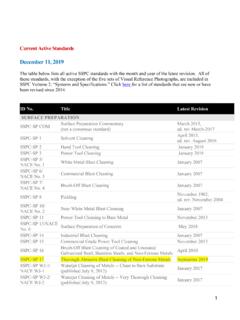Transcription of ACRYSOL Rheology Modifiers Product Solutions Guide
1 ACRYSOL Rheology Modifiers Product Solutions GuideDow Coating Materialspg 2 Low-shear conditions are typically experienced by the paint while it is in the can, during brush and roller loading, and immediately after it has been applied to the wall. During these phases, sufficient low-shear viscosity is needed to resist pigment settling, paint spattering and film sag. Brookfield viscosity is a common measure of a paint s low-shear viscosity. Mid-shear conditions are created during paint stirring and pouring, and some types of pumping. During these phases, mid-shear viscosity helps to facilitate good in-can appearance and handling properties and may also affect spattering. Stormer or KU viscosity are common measures of mid-shear viscosity. Rheology Modifiers that are classified as KU builders generally offer good mid-shear viscosity. High-shear processes include brushing, certain aspects of rolling, and spraying.
2 High-shear viscosity influences brush and roller drag, as well as film build and thus contributes to hiding. High-shear viscosity is also referred to as ICI viscosity. Rheology Modifiers that are classified as ICI builders generally offer good high-shear Terms Viscosity [cPs,P] is the resistance of a material to flow. It is defined as shear stress divided by shear trends may come and go, but Rheology makes a lasting impression on consumer paint preference. How the paint feels when it is stirred, poured and applied to the wall creates a signature experience that helps to define and enhance your brand. Through experienced technical support and a robust line of Rheology Modifiers , Dow Coating Materials can help you create a Rheology profile for your paint line that delivers a high-performance paint experience on and off the Rate RegionsLowIn the can and on the wallBrush and roller loadingMidHighShear Genius: A successful Rheology package adapts to changing shear rates while supporting specific formulation Rate [1/sec] is the velocity gradient in a flowing material.
3 It is defined as velocity divided by Stress [dyn/cm2] is the force per unit area used to move a material. It is defined as force divided by area. Brush drag, roller slip, and back pressure in spray applicationspg 3 Ranges of Viscosity (Typical Waterborne paint ) With every change in shear rate, paint undergoes a change in viscosity. To better understand how a paint behaves at different shear rates, we typically look at three different types of viscosity measurements. Associative Thickeners also employ water-soluble polymers, but they do not thicken through water absorption. Instead, these polymers contain hydrophobic groups that interact with one another and with the latex Brookfield viscosity measures low-shear flow and is indicative of paint viscosity when it is in the can and after it has been applied to the wall. KU viscosity measures mid-shear flow and is indicative of paint viscosity when it is being loaded onto the brush or roller and as the brush or roller leaves the wall.
4 ICI viscosity is a measure of high-shear flow and is indicative of paint viscosity when it is being rolled or brushed onto the wall. How Rheology Modifiers ThickenVolume Exclusion Thickeners employ water-soluble polymers that swell with water and take up space in the paint . Cellulose ethers, such as CELLOSIZE Hydroxyethylcellulose (HEC), fall into this category. These All three shear rate regions should be considered when building an optimum Rheology profile. ViscosityShear RateLow ShearMid ShearHigh ShearICIB rookfieldKUParticle SettlingLevelingFlowBrush DragRoller SlipSpray ApplicationFilm Build In-can FeelBrush LoadingRoller LoadingSag ResistanceKey Terms Newtonian describes a viscosity that is constant, regardless of the shear rate. Simple fluids such as water, solvent and oil are examples of Newtonian describes a complex relationship between shear stress and shear rate that results in viscosity being dependent on shear rate.
5 paint is a non-Newtonian describes a non-Newtonian fluid that loses viscosity when shear rate increases, but recovers that viscosity when the shear rate decreases. types of thickeners create viscosity through chain entanglement and particle flocculation. Their ability to thicken is directly proportional to their molecular weight and concentration in the paint formulation. The greater the molecular weight, the more efficiently they in the formulation to create a three-dimensional network. Thickening results because this network restricts the motion of the latex 4 ASE Chemistry Overview Rheology Modifiers that thicken by volume exclusion include cellulosic ethers and ASE alkali soluble (or swellable) emulsions. Cellulosic ethers are nonionic, water-soluble polymers derived from natural fibers. They thicken by absorbing water and creating chain entanglement and flocculation. Cellulosic ethers are efficient and shear-thinning, but their dry powder form can be difficult to handle in commercial-scale production.
6 COOHpH ~ ~ *COO*COO*COO*COO*Figure 2. pH-triggered thickeners are insoluble at low pH and soluble at high pH. ASE and HASE Rheology Modifiers are pH-triggered 1. Alkali soluble/swellable emulsions (ASE) contain copolymer chains of methacrylic acid and acrylate ester in a ratio at or near 50 ASE thickeners are copolymers of methacrylic acid and ethyl acrylate ester (Figure 1.). They were developed to mimic the Rheology properties of cellulosics, but facilitate an easier-to-use, more cost-effective Product . Like cellulosic ethers, ASE products thicken via water absorption and swelling. Different rheological characteristics are achieved by manipulating the molecular weight, as well as the types and amounts of acid and ester thickeners rely on a change from low to high pH (neutralization) to trigger thickening. The trigger is built into the copolymer by creating an approximately 50:50 ratio of methacrylic acid, which is soluble in water, and an acrylate ester, which is not soluble in water.
7 When the acid is un-neutralized (low pH), the copolymer is insoluble in water and does not thicken. When the acid is fully neutralized (high pH), the copolymer becomes soluble and thickens (Figure 2.).ACRYSOLTM ASE Rheology Modifiers are supplied at low pH (< 5) and maintain a low as-supplied viscosity (<100 cP) at solids of up to 35%. This is in stark contrast to cellulosic ethers, which develop a viscosity of several thousand centipoise even at solids as low as When subject to pH 8 or higher in the coating formulation, ASE copolymers solubilize, swell and thicken the formulated coating through volume exclusion. The degree of thickening is related to the molecular weight of the copolymer. Because their performance depends on water absorption and swelling, ASE thickeners tend to be very high in molecular weight, which allows them to thicken efficiently. The Rheology profiles they create are typically steeply shear-thinning (pseudoplastic), and so ASEs are well suited to building high viscosity at very low shear Quick Summary ASE thickeners contain a balance of methacrylic acid and acrylate ester.
8 They are supplied at high volume solids in liquid form. Thickening is triggered by a change from low to high pH. ASE thickeners are steeply shear-thinning and well suited to high-viscosity, thick-film applications such as caulks, mastics, EIFS finishes, driveway sealers and craft paints. pg 5 HEUR Chemistry Overview HEUR is an acronym for hydrophobically-modified ethylene oxide-based urethane. This category of Rheology modifier was developed after the introduction of ASE and HASE to address limitations in flow, leveling and water sensitivity. HEURs offer a wide range of rheological properties, from Newtonian (very little shear-thinning) to quite pseudoplastic (strongly shear-thinning). Unlike ASE or HASE thickeners, HEURs are non-ionic and soluble at any pH. This solubility is due to the polymer s ethylene oxide backbone (Figure 3.), which is water soluble and makes up the majority of the polymer HEUR structure imparts viscosity almost exclusively through a three-dimensional associative network.
9 This degree of associative thickening is notably higher than that for HASE polymers and is the reason that HEURS offer exceptional flow and leveling. This typically makes them an excellent choice for high-gloss and semi-gloss formulations. However the range of rheological properties that HEURs can create often make them suited for satin to flat formulations as HEURs are soluble in water regardless of pH, it is often necessary to add solvent or surfactant to reduce as-supplied viscosity to manageable levels. ACID SUPPRESSION Technology takes the successful idea of pH-triggered thickening from ASE and HASE chemistry and applies it to HEURs, thus facilitating low-VOC formulations without added surfactant. This feature is accomplished via a slight modification of the end group to include a tertiary amine (Figure 4.). At low pH, these amines are protonated, become charged, and repel, preventing the hydrophobe association that creates thickening.
10 As a result, the as-supplied Product viscosity remains very low. NHOOOOnNHORRNHNHOOOOR'R'mFigure 3. HEUR morphology features repeating polyethylene glycol units at the center and hydrophobic groups on either end. Isocyanate linkers on either side of the polyethylene oxide connect the polymer backbone to hydrophobic end groups.< 6 pH No Association> 8 pH Full AssociationFigure 4. ACID SUPPRESSION Technology employs pH-triggered association and thickening in Chemistry Overview HASE stands for hydrophobically-modified alkali soluble emulsion. These are tertiary polymers that build on the ASE chemistry by adding a hydrophobic acrylic ester monomer to the polymer composition. HASE Rheology Modifiers retain the pH dependent behavior and easy handling advantages of their ASE counterparts, but in addition to absorbing water, HASE Rheology Modifiers also thicken via hydrophobe association. This mechanism, known as associative thickening, offers performance properties over a wider range of shear levels and facilitates a wider range of Rheology profiles than is possible with volume exclusion thickeners such as ASE and cellulosic offerings.







